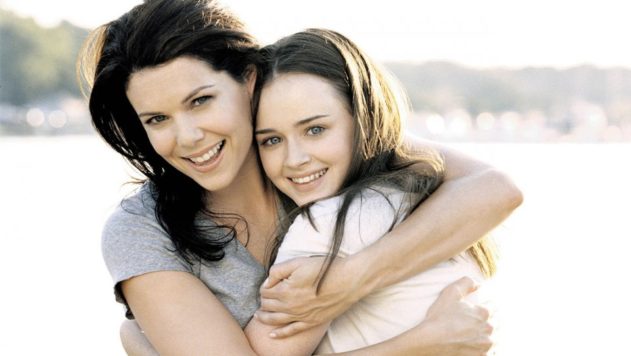A family of two is not any less of a family. A family like mine no longer felt incomplete.
With Mother’s Day fast approaching, I can’t help but think about how the year 2015 changed my life, not because I shaved my head (which I did), but because the television show “Gilmore Girls” resurfaced on Netflix.
“Gilmore Girls” charmed a TV audience with its endearing and unique plotline in 2000 — independent, single mother Lorelai raises fiercely smart Rory in Stars Hollow, a fictional Connecticut suburb where Rory breaks every assumption one might have about being the daughter of a once-pregnant teen. Rory, 15 at the series start, and Lorelai, in her 30s, both embark on journeys of self-discovery while their unprecedented bond, tied by witty banter and tongue-in-cheek pop culture references, only strengthens over seven beloved seasons.
When the show resurfaced in 2015, suddenly friends, classmates and coworkers reached out to my mom and I, wanting to introduce us to the show, telling us about the numerous similarities between our lives and the television characters’. It seemed almost freaky, and too good to be true.
Rory spent most mornings squeezing into black Spanx shorts and slipping into a crisp grey pleated uniform skirt. So did I. Layering a stiff navy sweater over an impeccably white polo shirt with the collar folded over, she prepared for her day as a student at her elite, private prep school. As did I.
As the Jew in a mass of Catholic school girls, and the only one raised by a single mom, the one thing that made me feel similar to my classmates was the uniform. I often feared that looking like them would lead others to believe that I had grown up like them. So I shaved my head, broke dress code, and rejected their popular trends, which helped me feel different. And then I watched “Gilmore Girls,” and suddenly I knew someone just like me.
Most people tend to read my story as a tragic one. My dad died two weeks before my fourth birthday and doctors diagnosed my mom with cancer shortly after. A theater actress in her career, she began to take on other roles in my life as both a mother and a father.
Like Lorelei, my mother raised me herself, receiving support from close friends and colleagues who flooded in as chosen family, the people who stepped up to care for me in times of need when her acting career and chemotherapy treatments prevented her from cooking dinner, or putting me to bed at night. Boyfriends came and went, some long-term and others who felt more like visitors. Some attempted to play the role of a father figure, but none stayed long enough to be offered the part.
Even while surrounded by a constant support system, our family of two felt small and so different from the families I saw elsewhere.
Prickly, imperfect characters with a complicated mother-daughter dynamic, Rory and Lorelai each have their faults. Rory takes poorly to criticism and shuts down in the face of failure. Lorelai struggles repeatedly with commitment, putting herself and Rory through a handful of serious romantic relationships, each one stripping them further of trust toward men. Both suffer from a particularly selfish strain of only-child syndrome and severe abandonment issues since the departure of Rory’s father.
When the show rebooted in 2015, their unconventional friendship founded on loving arguments and sharp wisecracks attracted audiences again. The show’s resurgence in popularity prompted a miniseries revival “Gilmore Girls: A Year In The Life” and a hilariously fresh spin-off podcast, “Gilmore Guys.”
The logo from Rory and Lorelai’s favorite diner became a recognizable icon that my classmates stickered to their laptop computers. The close and trusting friendship I shared with my mom, like Rory and Lorelai’s, prompted jealousy among the girls in my class. In high school, as most of us began to experiment with booze and boys, my classmates felt the need to hide these things from their parents. Seeing Rory and Lorelai have these conversations successfully gave me the template to have a uniquely trusting friendship with my mom. I could tell her anything, and I did.
The late weekend nights we spent snuggled up on the couch in our coral-painted living room binge-watching these episodes that reflected our relationship so precisely have been the most intimate moments we have shared in my entire life. Surviving loss, suffering grief, fighting cancer and toughing out our own fears of abandonment all tested our strength as a family unit of two, but seeing our dynamic depicted on screen was the most empowering thing I experienced while learning to navigate a world where I hadn’t seen anyone else like myself.
Scenes where Lorelai and Rory fought sometimes felt hauntingly familiar while an unforgettable moment where they lean against one another on the dance floor of a town event helped me to understand that a family of two is not any less of a family. A family like mine no longer felt incomplete.
As Mother’s Day gets closer, I realize that there’s a way in which seeing yourself in a story that isn’t one you’ve written validates your existence. What “Gilmore Girls” did for me is something other media can and should do for all those who feel they are on the outskirts of conventional society. While some families may honor their mothers with Hallmark cards this upcoming holiday, I plan to celebrate with mine curled up on the couch watching our favorite TV show.
Julia-Rose Kibben is a student at the University of Colorado Boulder studying journalism and gender studies with a focus in sports journalism and media representation.
Other Links:

